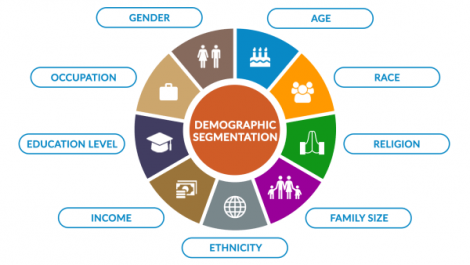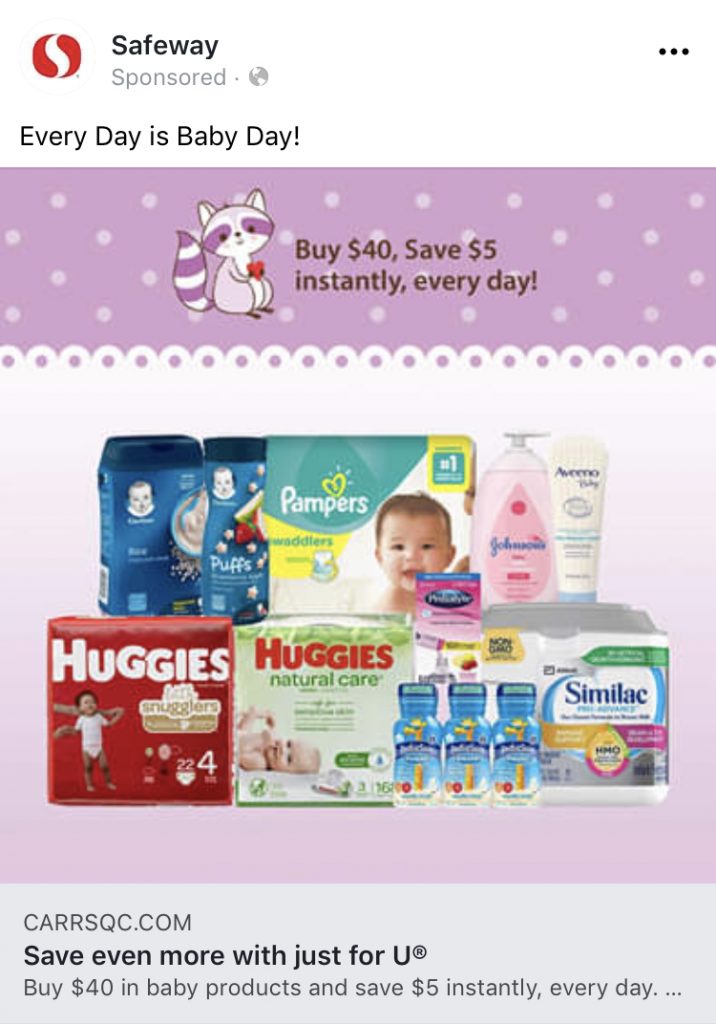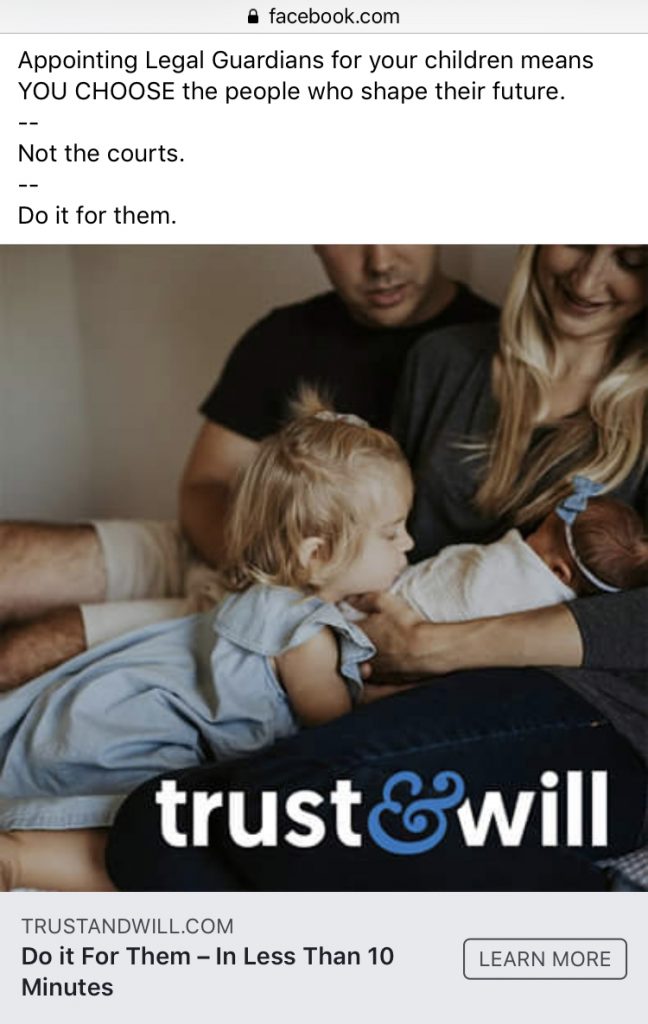Demographic segmentation
You can see demographic segmentation at play when you walk into any grocery store. Depending on where you live, you’ll see all kinds of different people.
Peek into their carts and you’ll get a glimpse of who they are. The young mother with a toddler strapped to her back may haul away Annie’s Organic Mac and Cheese, strawberries, and baby wipes. The overeager college student might grab a mountain of candy and soda for an all-night cram session.
Every person’s lifestyle demands a different set of items.
This concept applies to consumers of every kind. That’s why everyone who sells a product needs to know who they’re selling to and what those people like.
Table of contents
- Table of contents
- What is demographic segmentation?
- What is a customer demographic?
- An example of a demographic
- What are demographic characteristics in marketing?
- What is included in demographic segmentation?
- Age
- Race
- Religion
- Family size
- Ethnicity
- Income
- Education
- Occupation
- Gender
- Why is demographic segmentation important?
- What types of products would you use demographic segmentation for?
- Examples of demographic marketing segmentation
- How does demographic segmentation help in marketing?
- What’s the best way to use demographic segmentation to my advantage?
- At PickFu, demographics you can target with our software include the following:
- Frequently asked questions
What is demographic segmentation?
Demography is the “statistical study of human populations, especially with reference to size and density, distribution, and vital statistics.” The main reason to study demographic segmentation is to help build your brand to fit your customers’ needs.
Demographic segmentation helps you personalize your products, services, and advertisements. The more a campaign is personalized, the more likely a customer is to click and purchase.
What is a customer demographic?
A customer demographic is a set of data pertaining to a group of people who purchase your product.
In marketing, segmentation is the act of breaking your target market into groups (segments) that share certain characteristics.
So, demographic segmentation is breaking your customer demographics into segments to better study their preferences, distastes, and buying tendencies.
An example of a demographic
A demographic could be any group of people who share a characteristic. For example, babies, teenagers, and older adults are each a demographic. So are dog owners and cat owners. And people who are single versus people who are married.
People can belong to several demographic groups at once. For example, you could be a dog-owning senior who’s single. Then you’d belong to three of the different demographic populations mentioned above!
Marketers generally look at one or two variables at a time. A person who is looking to sell dog toys won’t particularly care if you’re single. Instead, that toymaker will only use target market demographics of dog ownership.
What are demographic characteristics in marketing?
In demographic marketing segmentation, groups are typically based on these demographic characteristics:
- age
- race
- religion
- family size
- ethnicity
- income
- education level
- occupation
- gender
What is included in demographic segmentation?
Included in demographic segmentation are the following segments:
Age
What appeals to a 10-year-old generally won’t appeal to a 60-year-old. A picture book about Amelia Earhart might catch the eye of a younger customer. A thick biography of the same person should be marketing to an older demographic.
Age segmentation means focusing on the age range most valuable to your product or service. Marketing demographic age brackets are usually 18-24, 25-34, 35-44, 45-54, 55-64, and 65 and older.
Race
A Black woman with curly hair will want different hair products than an Asian woman with straight hair. Knowing these differences helps businesses understand the needs of the people they’re marketing to.
Religion
A Christian audience might be interested in a new Bible app, but a Hindu audience likely wouldn’t be.
Family size
Will a family with six young kids want a “buy two, get two free” deal on diapers? Absolutely! But a family with older kids won’t be interested.
Ethnicity
In areas where high populations of Latin Americans call home, business owners would be smart to invest in Latin American grocery stores and restaurants. In places with tiny populations of Latinx residents, the same restaurants and grocery stores won’t find nearly as much business.
But general-market stores examine the ethnic makeup of their surrounding areas, too. Because ethnicity influences the kind of food someone buys, this kind of grocery market segmentation could drive the kinds of products that line the shelves.
Income
Huge chain stores like Walmart know their target demographic is people with lower income. These Walmart customer demographics drive decisions about which regions of the country to place retail outlets. Walmart also prices products accordingly, providing a wide array of products — from toothpaste and clothes to groceries and jewelry — all at super affordable prices.
A store like Anthropologie, on the other hand, serves a market it knows is willing to fork out bigger bucks for pricy home decor and clothing items.
Education
If you’re opening a bookstore, you’ll want to find out the average education level in your community. Do you have a lot of kids and high-school non-graduates whose reading needs will tend toward commercial fiction? Or are you surrounded by literary professors who’ll demand fat stocks of Ye Olde Classics?
Related education segmentation examples might include how tech-savvy you need your product’s audience to be, or whether they have white-collar or blue-collar professions. Best Buy target segmentation likely looks at education level.
Occupation
If you’re part of the baby boomer generation, you probably love a steady 9-to-5 job with benefits. Maybe you work in an office, so business attire and shoes that both suit your professionalism and are comfortable are highly relevant to you.
Look down through the generations to millennials and Gen Z-ers, and you’ll see people who are more interested in finding adventure in their jobs. On the other hand, many people from younger generations would rather build small businesses from the ground up. They’re focused on making a living, however meager, doing what they love. They might, therefore, care more about finding the perfect vintage truck for their mobile flower shop than about scoring the perfect leather dress shoes
Gender
Gender segmentation can be both wise and unwise. Kids’ toys are sometimes needlessly gendered. Often, children play with toys that cross traditional gender boundaries.
However, clothing is a product segment where gender plays a necessary role. Clothing will fit one gender differently than another. As age increases, so do divides in gender behavior, paving the way for marketers to study the different characteristics and purchasing habits of each.
Why is demographic segmentation important?
When demographics are segmented, the narrower focus can help an organization target its consumers more accurately. It can study the segments to find out how best to serve its customers’ needs.
What types of products would you use demographic segmentation for?
Every product on the market can benefit from a marketing strategy that uses demographic segmentation. Why? Because all feedback is not created equal. It’s better to ask the opinions of people who are likely to buy or use your product than those who aren’t. Likely customers will give you better insights into how well your marketing and messaging work.
One author used demographic segmentation to find out which book cover catches the eye of people who read at least one book a month. After all, non-readers or people who don’t read very often aren’t likely to pick up the book, no matter how appealing the cover.
Another marketer used demographic segmentation to find out which icon for a mobile dating app appeals to people who are single. The kind of information this segmentation provides will help the app serve its customers — singles who want to be couples — much better.
With PickFu, you can create polls that target different
Examples of demographic marketing segmentation
It’s well known that massive companies like Facebook and Instagram use extremely specific demographic segmentation to help advertisers effectively target their users.
Think of your own encounters with social media advertisements. If you’re the parent of a young child and you enjoy reading books, you might see ads pop up in your Facebook or Instagram feeds similar to these three below.
First, a Safeway ad for diapers and other baby necessities.
Second, an advertisement for an online will-creating service — something every parent absolutely should use ASAP.
And last, an advertisement for a shirt that appeals to your inner bookworm.
Companies like Facebook know that if you’re going to have to look at advertisements on your social media pages, you’d rather look at relevant products and services than things you don’t care about and aren’t likely to buy.
Demographic segmentation is crucial to any marketing strategy. You want the ads your audience sees to compel them to act. If they don’t care about the ads because the ads have nothing to do with their life, that’s marketing money gone to waste.
While it may seem strange that social media sites seem to know exactly what everyone likes, it’s all a marketing strategy using demographic segmentation. All the big businesses are doing it, all the time.
Says one marketing expert, “Facebook combines the information from data collection companies like Epsilon, Datalogix, Acxiom, and BlueKai with
Later, that information will be used to target ads specifically to that pizza-loving person.
If you’d rather take a front-door approach to demographic segmentation, using PickFu is a simple and effective way to do that because users know that they’re offering their information, and they do it willingly.
How does demographic segmentation help in marketing?
By targeting a specific demographic segment, such as parents who have several children, you’ll get the most relevant answers to your marketing research questions. You’ll know what your customers prefer and what they’re most likely to buy.
What’s the best way to use demographic segmentation to my advantage?
As a marketer, the best way to use demographic segmentation to your advantage is to:
- Target the right customers
- Customize your products and advertisements to catch those customers’ attention
- Save money (by not wasting ad space on people to whom your product might be irrelevant)
- Anticipate your customers’ future wants and needs and tailor your product accordingly
Have you written a book? Designed an app? Are you setting up an e-commerce store? PickFu can help you with demographic segmentation.
If you know your target audience (and in this day and age, you absolutely should know exactly who you’re selling to), create a poll targeted at that demographic.
Ask them which version of your product would make them more willing to purchase it.
At PickFu, demographics you can target with our software include the following:
- Age range – 18-24 year-olds, 25-34s, 35-44s, 45-54s, 55-64s, 65-74s
- Cooking interest – non-cookers, light cookers, and/or avid home cooks
- Cosmetics / body care – heavy body care users and/or basic body care users
- Ethnicity – whites, Blacks, Hispanics, Asians, ethnicity-other
- Gender – male, female
- Number of kids – how many kids a person has: no children, 1 child, 2 children, and/or 3+ children
- Nutritional supplements – whether a person takes or doesn’t take nutritional supplements
- Relationship status – single people or
married people - Religious affiliation – Non-religious, Christianity, and/or others
- Sexual orientation – heterosexuals or LGBT+
Frequently asked questions
Breaking your customer demographics into segments to better study their preferences, distastes, and buying tendencies.
Age, race, marital status, number of children — all of these are examples of personal demographics.
You can use the information you discover from demographic segmentation to shape the way you make, advertise, and sell your product.
Demographic segmentation helps you spend your marketing dollars more effectively. By customizing your products and advertisements to catch the attention of the groups to which your product is relevant, you aren’t wasting your spend by showcasing your brand to just anybody.
A demographic segment is a group of people clustered together by one demographic trait, such as age range, religion, or marital status.
Big companies like Facebook and Safeway use it, as do small companies or even authors of self-published books. Everyone can use demographic segmentation to better understand their customers. Some companies use demographic segmentation for their ads, which helps them narrow down their target audience more accurately.
Geographic segmentation looks at audiences based on their location. Demographic segmentation looks at audiences based on other shared traits, such as age range or family size. You can combine geographic and demographic segmentation into what is called geodemographic segmentation.
It’s possible. Think of the generalizations marketers have made for years about the group known as millennials. While it’s tempting to lump segments together to understand their similarities, humans have unique motivations driven by personal experiences.
Starbucks strategically chooses store locations based on demographic segmentation. For example, the company targets areas with middle- to high-income office workers because they have discretionary income to spend on premium-priced coffee. Starbucks also appeals to technology-minded customers by offering free Wi-Fi and a popular mobile app.
Absolutely. For example, a chain like Planet Fitness emphasizes a no-pretension, low-cost gym atmosphere, while a chain like Equinox emphasizes an exclusive, premium atmosphere. Each brand thinks about how its core customer approaches the idea of fitness. It then crafts its brand experience and marketing accordingly based on their customers’ attitudes and behaviors.






